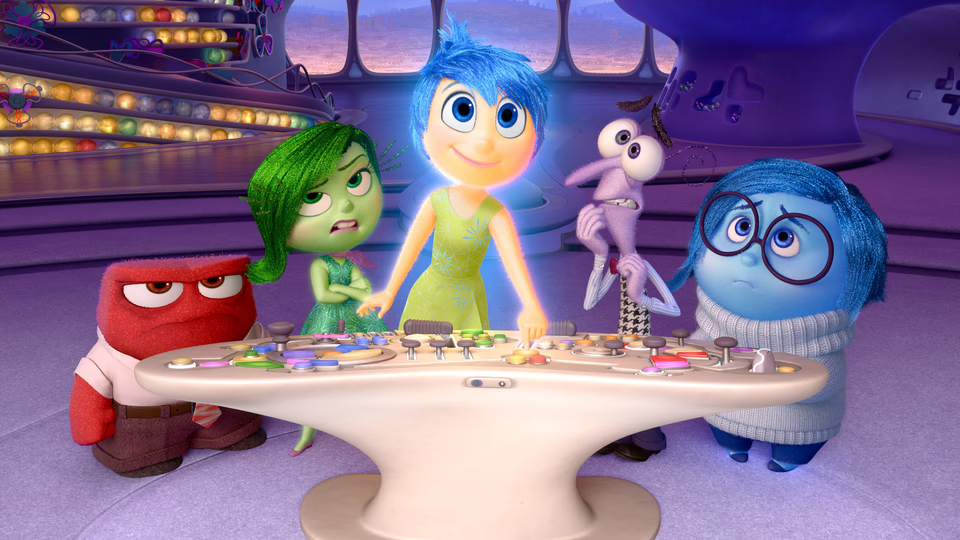Inside Out

Inside Out is an ambitious animated feature that opens inside the mind of a newborn girl named Riley. There, we meet our protagonist Joy, an anthropomorphic emotion. In voicing Joy, Amy Poehler manages the near-impossible feat of being relentlessly optimistic and perky without ever being annoying.
Soon, Riley’s other core emotions—Disgust, Fear, Anger and Sadness—appear. The group operates out of Headquarters, a Space Needle shaped building at the center of Riley’s consciousness. Using a pastel-infused command-console that looks equal parts Playskool and Apple, they influence Riley’s behavior.
Early on, Joy dominates. Disgust, Fear, and Anger provide comic relief. Riley grows from infant to toddler to pre-teen. Outside Headquarters, islands akin to giant amusement parks spring to life. These represent Riley’s personality. They grow as new happy memories are formed.
It’s an efficient opening act with one misstep. Sadness is frustrating. Her actions feel plot-driven and, compared to Joy, her character arc is shallow.
The plot kicks in when Riley, now age 11, finds herself uprooted by a move to San Francisco. At first, Joy coaxes Riley to remain positive. But a dilapidated house, frazzled parents, a new school, and a moving van that seems to circumnavigate the globe en-route to San Francisco, take their toll.
Things get even worse when Joy and Sadness find themselves stranded far from Headquarters. This renders Riley unable to feel either of their respective emotions.
Now, the film shifts to adventure as Joy struggles to get them back to Headquarters. On the way, the pair wander through Riley’s long-term memories and meet her almost-forgotten imaginary friend, Bing Bong.
Meanwhile, Riley, unable to feel anything but anger, fear and disgust, begins lashing out at her parents and friends. As she does, the islands of her personality crumble and fall away into nothingness.
As Joy’s desperation to reach Headquarters grows, she and Sadness induce a nightmare involving a giant clown. It’s a sequence that will give a fair number of viewers nightmares of their own.
Soon after, the film offers a scene of unexpected depth. Joy and Bing Bong find themselves in a desolate dumping-ground where memories dissolve into dust. We see images of young Riley laughing and playing with Bing Bong. As these memories dissolve and blow away, Bing Bong himself fades from existence. He accepts his fate with a quiet dignity that belies his goofy exterior. It’s a poignant moment that forces older viewers to acknowledge the loss of innocence inherit in growing up1.
It’s this willingness to tackle complex themes without patronizing the audience that makes Inside Out an impressive film. Odds are, you’ll think it a wonderful movie. I did.
Well, almost.
To explain my objection, I must discuss the ending. Spoiler alert.
Still here? Okay.
The film climaxes with Riley, finally able to feel her emotions, crying and hugging her parents. As she does, the missing islands of her personality spring back into existence. Cut to a short time later. Riley is back to her old self.
For a film that felt so honest in its depiction of the human condition, this felt disingenuous. For all the drama of the islands of personality crumbling into the void, a simple hug reconstructs them exactly as they were?
Where are the consequences?
This was a chance to show Riley adjusting to the move, but at a cost. Maybe part of her never comes back. Maybe the relationship with her parents is forever altered. Maybe when that island returns it’s different, maybe smaller. Anything but the saccharine, everything’s okay bit of fluff we’re given. Sure, new memories are now mixes of emotions instead of pure joy, but this is peddled as a wholly positive change. Where’s the trade-off?
Inside Out drives home the message that growing up means accepting sadness as a part of life, yet it can’t apply that lesson to its own ending.
Notes
-
Saddest Disney scene I can remember. Bambi’s mom has nothing on this. ↩︎